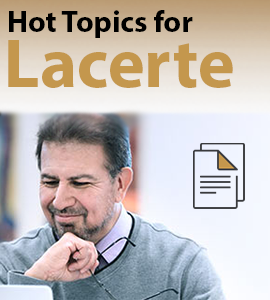- Topics
- Training
- Community
- Product Help
- Industry Discussions
- User Groups
- Discover
- Resources
- Intuit Accountants Community
- :
- Lacerte Tax
- :
- Lacerte Tax Discussions
- :
- I was hoping for an I-3 to be called so I could hit the b...
Where is schedule B-2?
- Mark Topic as New
- Mark Topic as Read
- Float this Topic for Current User
- Bookmark
- Subscribe
- Printer Friendly Page
- Mark as New
- Bookmark
- Subscribe
- Permalink
- Report Inappropriate Content
Best Answer Click here
![]() This discussion has been locked.
No new contributions can be made. You may start a new discussion
here
This discussion has been locked.
No new contributions can be made. You may start a new discussion
here
Accepted Solutions
- Mark as New
- Bookmark
- Subscribe
- Permalink
- Report Inappropriate Content
Typically between B-1 and B-3.
B-4 I can give a better answer, I would need to know what type of return you are trying to do and which year.
Answers are easy. Questions are hard!
- Mark as New
- Bookmark
- Subscribe
- Permalink
- Report Inappropriate Content
Typically between B-1 and B-3.
B-4 I can give a better answer, I would need to know what type of return you are trying to do and which year.
Answers are easy. Questions are hard!
- Mark as New
- Bookmark
- Subscribe
- Permalink
- Report Inappropriate Content
- Mark as New
- Bookmark
- Subscribe
- Permalink
- Report Inappropriate Content
Slava Ukraini!
- Mark as New
- Bookmark
- Subscribe
- Permalink
- Report Inappropriate Content
Electing out is in Screen 5 as the last item, with a link there to the Sch B-2 for Shareholders of S Corp Partners
1=Partnership is electing out of the centralized audit regime under section 6221(b)
Other Information (Schedule B) Screen 5; Code 58
Check the box, or enter 1, if the partnership is electing out of the centralized audit regime under section 6221(b). If Yes, complete Schedule B-2 and skip the Designation of Partnership Representative section. See the requirements below to make sure the partnership can make the election. Also, see Form 1065 Instructions for more information.
If the Partnership has any partners that are S Corporations, use Schedule K-1 Miscellaneous (Screen 32), Schedule B-2: If Partner is an S Corporation” section to enter the required shareholder information.
A partnership can elect out of the centralized partnership audit regime for a taxable year if the partnership is an eligible partnership that year. A partnership is an eligible partnership in the taxable year if it has 100 or fewer eligible partners. Eligible partners are individuals, C corporations, S corporations, foreign entities that would be C corporations if they were domestic entities, and estates of deceased partners. The determination as to whether the partnership has 100 or fewer partners is made by adding the number of Schedules K-1 required to be issued by the partnership to the number of Schedules K-1 required to be issued by any partner that is an S corporation to its shareholders for the taxable year of the S corporation ending with or within the partnership taxable year. A partnership is NOT an eligible partnership if it is required to issue a Schedule K-1 to any of the following partners.
• A partnership.
• A trust.
• A foreign entity that would not be treated as a C corporation were it a domestic entity.
• A disregarded entity described in Regulations section 301.7701–2(c)(2)(i).
• An estate of an individual other than a deceased partner.
• Any person that holds an interest in the partnership on behalf of another person.
Answers are easy. Questions are hard!
- Mark as New
- Bookmark
- Subscribe
- Permalink
- Report Inappropriate Content
B-2 is the "opt out" for the new partnership audit rules.
I suspect it won't be available until a future update.
- Mark as New
- Bookmark
- Subscribe
- Permalink
- Report Inappropriate Content
Answers are easy. Questions are hard!
- Mark as New
- Bookmark
- Subscribe
- Permalink
- Report Inappropriate Content
I don't know, I burned my draft card back in the 1960's.
https://www.irs.gov/pub/irs-dft/f1065sb2--dft.pdf
Answers are easy. Questions are hard!





